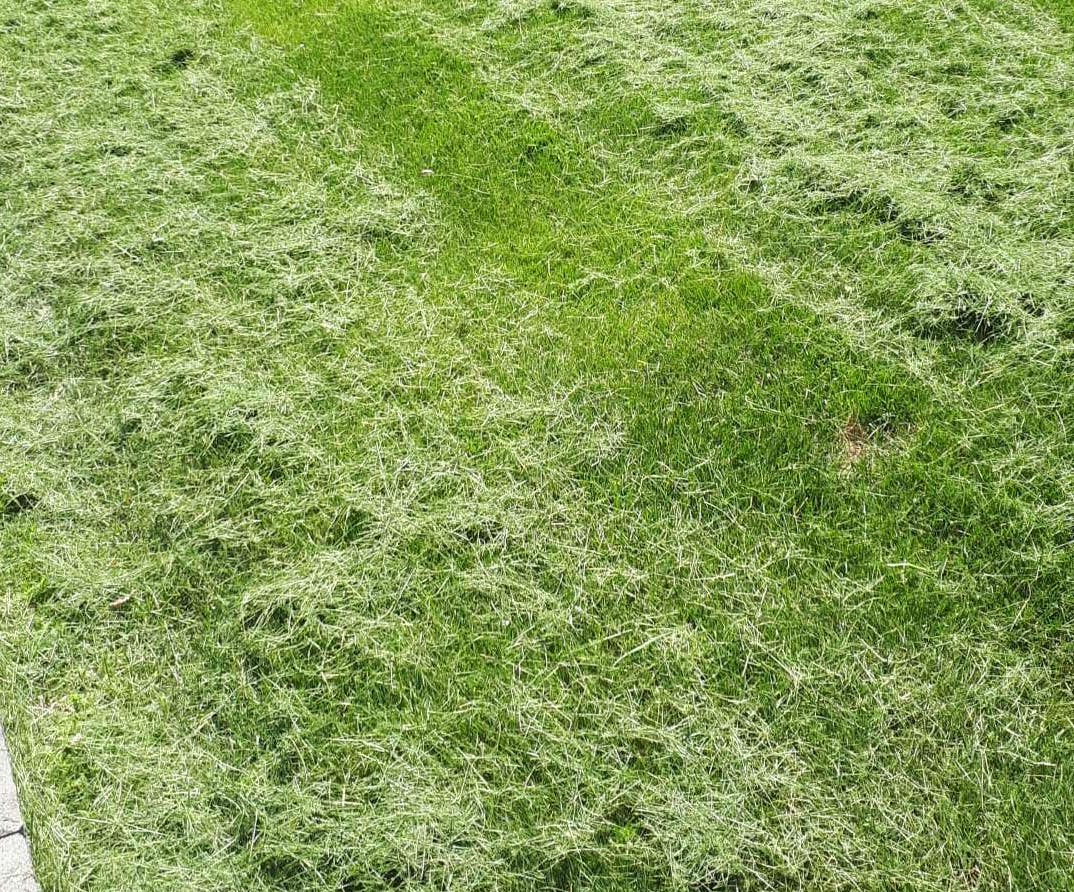So, your grass’ growing season is here, whether it is summer for warm-season grass or spring and fall for cool-season grass. In that case, lawn mowing becomes more frequent as grass grows actively. In addition, it means dealing with more grass clippings.
Your lawn maintenance routine doesn’t end with having a uniformly cut yard, as you must also have to collect the grass clippings to make your lawn neat and pleasant.
While leaving the grass clippings on your yard is perfectly okay, it may not be the best choice, especially if you want a tidy yard.
Furthermore, there are multiple useful things you can do with grass clippings. Keep reading for excellent ideas.
What Are Grass Clippings?
They are the small grass pieces cut by a lawnmower while mowing a lawn. As the mower blades spin, they cut the grass into small pieces and then deposit them onto the lawn.
Grass clippings mainly comprise water and contain nutrients like nitrogen, calcium, phosphorus, magnesium, and potassium, which are vital for a lawn’s health.
The length of the grass clippings may vary depending on how short you mow your lawn. For instance, they will be short if you follow the one-third rule.
Amazing Things You Can Do With Grass Clippings
Instead of filling your garbage bins with grass clippings, why not try something more beneficial? After all, there are plenty of things to do with them rather than just discarding them. These include:
1. Grasscycling
This is the practice of leaving grass clippings on your lawn after mowing instead of collecting and disposing of them. Doing so helps the nutrients in the grass clippings recycle into your lawn soil, providing your grass with a natural fertilizer source.
The grass clippings slowly release their nutrients into the soil as they decompose. Besides fertilizing your lawn, grasscycling boosts soil health and conserves water by helping your lawn retain moisture for much longer.
Also Read: How to get rid of yard waste
In addition, you won’t spend much money on fertilizer or much time disposing of lawn waste if you grasscycle. If you intend to grasscyle, mow regularly and avoid clumping and an uneven cut by adhering to the one-third rule and not mowing a wet lawn.
2. Convert It Into Mulch
You do not need to buy mulch when you have grass clippings. To convert grass clippings into mulch, spread them across your grass or pile them around the plants in your container gardens or garden beds.
You must ensure the grass clippings layer is thin enough to allow air and water to penetrate the ground. Therefore, keep the layer 1 to 2 inches thick and keep the clippings away from your plants’ stems to curb moisture buildup and disease.
Grass clippings as mulch offer these benefits:
- Retains moisture by reducing evaporation from your lawn surface.
- It blocks out sunlight, which weed seeds need to germinate, thus suppressing weeds.
- It helps keep the soil cool during hot water and warm when it gets cold.
- It keeps soil from washing away during heavy rains, thus reducing soil erosion.
- It releases nutrients into the ground as the clippings decompose.
Also Read: Natural Ways to Kill Weeds in Grass
3. Add It To Your Compost
Grass clippings have high nitrogen content, which plants need to grow and stay healthy. Therefore, if you mix grass clippings with the other organic materials inside your compost pile, they will disintegrate and decompose, providing your garden with a nutrient-rich soil amendment.
Moreover, grass clippings help balance your compost pile’s carbon-to-nitrogen ratio. Typically, composting requires a carbon-to-nitrogen ratio of about 30:1.
The grass clippings’ high nitrogen content helps balance the carbon-to-nitrogen ratio in a pile with mainly carbon-rich materials like leaves and leaf branches and quickens the decomposition.
Mix the grass clippings with the other compost contents properly. Also, don’t add too much at once to avoid creating a dense, matted layer that may produce unpleasant odors and fail to decompose well.
4. Livestock Feed
If you have farm animals that eat plants, you can supplement their feed with grass clippings. Animals that eat grass clippings include cows, goats, rabbits, and guinea pigs. You can feed your animals fresh grass clippings or convert them into hay by drying them.
Feed your livestock grass clippings with moderation and cautiously because they can ferment quickly, causing digestive issues in some animals.
Additionally, grass clippings treated with herbicides or pesticides can harm animals’ health, so avoid them.
5. Make Liquid Fertilizer
Another ingenious way of using grass clippings is to convert them into liquid fertilizer for your grass and plants.
Here’s how to make liquid fertilizer:
- Fill a bucket or container with fresh grass clippings, then cover the grass clippings with water, making sure you entirely cover the clippings. However, don’t fill the bucket because the mixture will expand as it ferments.
- Keep out insects and debris by covering the bucket with a cloth or lid.
- Let the mixture ferment for 2 to 3 weeks while stirring it occasionally to ensure the grass clippings are fully submerged in the water.
- Once the mixture has fermented, strain the liquid using a sieve or cheesecloth.
- Dilute the liquid fertilizer with water, with the quantity varying depending on the fertilizer’s strength and your plants’ needs. As a general rule, dilute the fertilizer with 5 to 10 parts water to 1 part fertilizer.
- Use liquid fertilizer on your plants, applying it directly to the soil around your plants. Alternatively, spray it onto the leaves.
6. Create A Lasagna Garden
A lasagna garden is a garden bed built by layering organic materials like the way you would layer ingredients in a lasagna. The organic materials layers eventually break down, forming nutrient-rich soil ideal for planting.
Start by laying cardboard or newspapers on the ground to smother any existing vegetation and prevent weeds from growing.
After that, layer organic materials such as grass clippings, leaves, compost, kitchen scraps, manure, and straw on top of the cardboard or newspaper.
Each organic material layer provides a different nutrient set to the soil and helps to create a healthy, balanced growing environment for your plants.
The bottom layers improve soil structure and water retention, while the top layers provide nutrients to your plants.
Over time, the organic materials in a lasagna garden break down and decompose, creating rich, fertile soil perfect for growing vegetables, herbs, and flowers.
7. Make Animal Bedding
Instead of buying bedding for your pets and livestock, use grass clippings as they are readily available, inexpensive, and sustainable.
However, don’t use grass clippings treated with chemicals, and ensure the bedding stays dry and clean to protect your animals from health issues.
Follow these steps to make animal bedding from grass clippings.
- Collect grass clippings from your lawn.
- Allow the grass clippings to dry out in a sunny, well-ventilated area for a couple of days to reduce the moisture content and keep the bedding from becoming too wet or moldy.
- Spread out a thick layer of dry grass clippings in the animal bedding area, ensuring the layer is at least 6 inches deep.
- Fluff up the grass clippings with a pitchfork or rake to create a soft, fluffy, comfortable bedding material for your animals.
- Add fresh grass clippings to the bedding to maintain the desired depth and softness.
- Remove wet or soiled bedding areas regularly and replace them with fresh grass clippings.
- Compost the used grass clippings and manure from the animal bedding to provide nutrient-dense, rich soil amendment for your garden.
8. Natural Dye
You can add colors to yarns and fabrics by making natural dye from grass clippings. This approach can produce unique, earthy colors like rich browns, pale greens, and pleasant patterns.
In addition, it is sustainable, cost-effective, and non-toxic since it uses readily available natural ingredients, so you’ll be protecting the environment in the process.
Here are the steps for making natural dye from grass clippings.
Collect grass clippings from your lawn. You will need approximately 1 pound of grass clippings for every 4 ounces of fabric or yarn.
Place the grass clippings in a large pot, add enough water to cover the clippings, then boil them. Once it boils, reduce the heat and let the grass clippings simmer for 1 to 2 hours to extract the color from the grass and create a dye bath.
Strain the grass clippings from the dye bath, and discard the solids.
Add your fabric or yarn to the dye bath, and simmer for 1 to 2 hours or until you achieve the desired color. Remember that the color may appear lighter or darker depending on the fabric or yarn’s fiber content.
Remove the fabric from the dye bath, rinse it thoroughly with cool water, then hang it in a shaded area, away from direct sunlight, until it dries.
Final Remarks
You can reuse or recycle the grass clippings you get from mowing your lawn with just a few ingredients, steps, and a bit of creativity.
Your lawn, plants, and animals will significantly benefit from the nutrients offered by grass clippings. Also, it will help your farm animals sleep in comfortable bedding.

Hey there, I’m Derek Schew, a writer for Lawnholic.com, where we cover everything and anything related to lawns. As someone who’s spent countless hours tending to my own lawn, I’m passionate about sharing my knowledge and helping others achieve the perfect yard. From lawn care tips to product reviews, I’m committed to providing our readers with the most accurate and up-to-date information available. So whether you’re a seasoned lawn enthusiast or just getting started, I invite you to join our community and discover the joys of a lush, green lawn.

